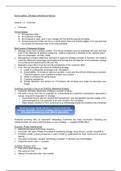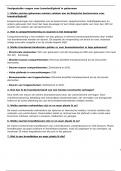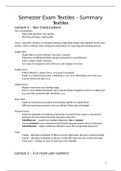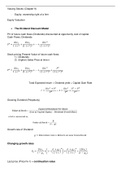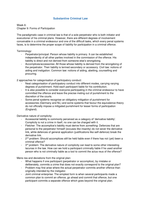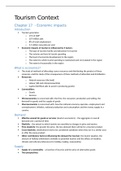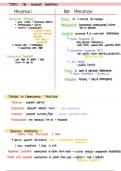Socrative Code – TCRUFHXO
Topic 1 – Global Economy
Ø Different countries have different currencies. (Foreign exchange)
Ø Countries are financially integrated with trade in goods, services and assets.
(Financial globalization)
Ø Policies have cross-country implications. (International policy transmission)
Ø Fluctuations in exchange rates affect the relative prices of home and foreign:
- goods (such as autos and clothing)
- services (such as insurance and tourism)
- assets (such as equities and bonds)
Ø Exchange rate crisis: a sudden and pronounced loss of currency’s value against
another currency following a period in which the exchange rate had been fixed or
Global Imbalances
relatively stable
Ø The last time US had a positive current account was in 1991 – so how do
they finance their deficits
Ø The graph shows the global imbalances – the green shows who pays for
the global imbalances and the red is who is causing the global imbalance
Ø External wealth – how countries finance their imbalances – Total wealth
or net worth is equal to your assets minus your liabilities
Ø External wealth is a country’s net credit position with the rest of the ECON 352 Topic 1: The Global Economy
world. I.e. the difference between country’s foreign assets (what it is owed by the
External Wealth: U.S. vs Argentina
rest of the world) and its foreign liabilities (what it owes to the rest of the world)
Ø Positive external wealth makes a country a creditor nation
Ø Negative external wealth makes it a debtor nation
Ø You sell assets abroad and you can finance your spending
Ø In 2002 in Argentina they were a 400% depreciation of the pesos –
however, Argentina improved its wealth and became a creditor after 2005 ECON 352 Topic 1: The Global Economy 25/45
Ø Sovereign governments can repudiate debt without legal penalty – if you default on
debt they do not have to worry because the international laws are not very easily
enforceable
Ø The main punishment can be exclusion from finance and/or trade – they changed
the maturities of the loans that countries can have – they can still roll-over their
short-term debt but cannot expand in the long-term
Ø Default means – can I please pay tomorrow – if you fail to pay everything you agreed
on the day you promised
Ø Country risk is the difference in the interest paid on a sovereign country’s bond and
a (relatively) safe U.S. Treasury bond
Ø Complete exclusion of trade is not a viable option
Ø Countries default because they can, and it is in their interest – risk premiums will be
affected by the currency and defaulting
Ø Risk premiums can affect macroeconomy as USA can borrow for almost free – but
gives loans for a very high interest
Ø Government actions influence economic outcomes:
, - decisions about exchange rates
- macroeconomic policies
- debt repayment
Ø Studies policies, rules and norms, or regimes in which policy choices are made
Ø Focuses on institutions the overall legal, political, cultural, and social structures that
influence economic and political actions
Ø We will focus on their features of the broad macroeconomic environment:
- restrictions to capital mobility
- a choice between a fixed and a floating exchange rate regime
- the quality of governance
Ø We will often divide countries into three groups:
- Advanced countries high levels of income per person that are well integrated into
the global economy
- Emerging markets mainly middle-income countries that are growing and
becoming more integrated into the global economy
- Developing countries mainly low-income countries that areGovernmentnot yetandwell
Institutions
Financial Globalization:
integrated into the global economy
Ø Before 1973 exchange rate was mainly fixed to the US dollar
which was fixed to the gold standard – and finally 1973 US
gave up the gold standard
Ø Financial openness is measured by summing up the
absolute values of imports and exports
Ø Countries use capital controls because you are fighting with black money – you don’t
like cash moving too much – and it is trying to preserve your fixed exchange rate
ECON 352 Topic 1: The Global Economy 32/45
Ø Fixed exchange is broken by capital flight – you can only take out so much money
out of the country
Ø For years, Zimbabwe imposed capital controls – in theory, U.S. dollars could be
traded for Zimbabwe dollars (ZWD) only through official channels at an official rate
Ø Black market rate was different – there will be guy behind the bank exchanging at
The Curious Case of Zimbabwe
different prices Exchange rate and Capital Control: ZWD vs USD
10
ZWD vs USD Eschange Rate History 32
1031
1030
Ø To determine the black-market prices, we have the parallel rates –
1029
1028
1027
1026
First Zimbabwean dollars per US dollar
1025
1024
and a OMIR rate – the law fund price will not hold if there are
1023
1022
1021
1020
1019
1018
1017
capital controls
1016
1015 Official
1014 Parallel
1013
OMIR/UN
1012
1011
Ø You can move stocks much easier than currency – the OMIR tracks
1010
109
108
107
106
105
very closely to the parallel rate than the fixed rate
104
1000
100
10
1
1/1/01 1/1/02 1/1/03 1/1/04 1/1/05 1/1/06 1/1/07 1/1/08 1/1/09
Ø Real rate was 1000x lower than the black market
Date
ECON 352 Topic 1: The Global Economy 35/45
Ø What is the probability that your government will expropriate your business – this is
one of the measurements used to see differences institutions
Ø It looks for something which is exogenous – which was beyond human control –
something bad such as droughts
, Topic 2 – Exchange Rates and the FOREX Market
Ø An exchange rate is the price of some foreign currency expressed in terms of a
domestic currency
Ø Two (equivalent) ways to quote the exchange rate (depending on domestic/foreign
perspective)
- Units of domestic currency needed to purchase one unit of the foreign currency
- Units of foreign currency needed to purchase one unit of the home currency
Ø X is put in front of items that are treated as currency but are not currency – such as
gold or silver – XAU and XAG
Ø EEUR/USD = 0.770 – this means that you need 0.770 Euros per 1 USD – and the
domestic currency is the Euro
Ø If the exchange rate changes to EEUR/USD = 0.759 – this means that the USD has
depreciated – if we want to look at appreciation for the Euro, we need to look at the
USD currency
Ø This is a 1.43% depreciation of the USD
Ø EUSD/EUR = 1.298 in period one and in period two EUSD/EUR = 1.318 – the Euro has
appreciated by 1.54%
Ø The value of appreciation and the value of depreciation is not always the same – Argentina: Fixed Exchange Rate until 2002
however there is a relationship between them
Ø Argentina tried to maintain its currency against the USD to a 1:1 ratio –
however in 2002 the central bank runs out of resources and there is a
huge spike since no one wanted their currency
Ø Depreciation means we need to pay more NZD to get more of another
currency Mexico: Crawling Band until 1994
Ø We can see that appreciation and depreciation are linked if we see AUSD = b-a/a and
DNZD = b-a/b
Ø Therefore, the appreciation of USD is just equal to b/a x DNZD
Ø The bigger b/a is the bigger the difference in appreciation and depreciation
Ø If we look at USD compare with ARS, the exchange rate went from 1USD = 1 to 1USD
=4 Multilateral (Effective) Exchange Rates
4 Implic
Ø AUSD = 4-1/1 = 300%
4.1 Includi
Including
weights raises th
Ø DARS = 0.25-1/1 = 75% So far, we looked at “bilateral” exchange rate (change) between two
Figures 3 and 4 shows how the bilateral trade
currencies.
Ø DARS x b/a = AUSD = 0.75 x 4 = 3 weight on the Australian dollar has been fairly stable. The
Economists calculate multilateral exchange rate changes by weights on the currencies of China, in particular, and other by around 3.5 p
Ø Suppose home country trades with two countries – ERexchange
aggregating bilateral appreciates against
rates using trade weights
an average over each currency in the basket. The resulting measure is
Country 1
to construct
be if only good
by 10% and depreciate against Country 2 bycalled 30% the change in the effective exchange rate.
Effective Exchange Rate for NZ: Trade-Weighted Index
Suppose 40% of Home trade is with country 1 and 60% is with
Ø It is important to look at trade volume – if there is little trade then a change in
Figure 3
country 2. Home as currency appreciates 10% against 1 but
depreciates 30% against 2. What’s the change in the effective Figure 5
currency will not have a large effect
TWI has been the official
35 percent NEER constructed by thepercent
Australia RBNZ35since the
late 1970s. In DecemberEuro2014, TWI had changed to include 17
China
exchange rate? 30
(rather than 5) currencies
countries
30
is included
Ø Suppose the trade volume with C1 = 40% and C2 = 60%
25 25
The weights on currencies are calculated using shares of bilateral
20 20
trade in goods and services (rather than goods only).
5 percent point
4 change
15 15
Ø The average will be (-0.1 x 0.4) + (0.3 x 0.6) = 0.14 = 14% – this shows that the
3
“The changes
10
introduced in December [2014] greatly increase
10
the2
country coverage of the TWI, and in particular include the significant
1
number5 of important Asian trading partners.” Steenkamp (2014:
5
13)
0
currency has depreciated
0 0
1990
1992
1994
1996
2000
2002
2004
2006
2010
2012
2014
Nominal Effective Exchange Rate
Ø Home’s effective ER has depreciated by 14% 1– foreigners will buy more goods in
Australia
Singapore
Exchange Rate Essentials
theory Multilateral Exchange Rates
InIngeneral,
NZ Trading Partners: Trade-Weights 1984 vs. 2014 Figure 4
general,suppose
supposethere
there are N currencies
are N currenciesininthe
thebasket,
basket, and Home’s
and
Ø NZ loved to trade with UK but then they joined the EU and their trade
trade
Home’swith all
trade N partners
with all N is:
partners is: 25 percent
4.2 Broad
Trade = Trade + Trade + . . . + Trade .
policies changed and NZ wasn’t trading with the UKTrade as= much
Trade + Trade + ... + Trade
20
1 2 N
1 2 N
15
2014
Applying
Applyingtrade
tradeweights
weightsto to each bilateral exchange
each bilateral exchangerate
ratechange,
change, the
Ø In general, suppose there are N currencies in the the basket, and rateHome’s
10
home country’s
home effective
country’s exchange
effective exchange (E (E ) will
rate change
) will change effective
effective 5
according
accordingtotothethe following
followingweighted
weighted average:
average:
trade with all N partners is Trade =
0
Australia
China
Euro zone
Singapore
Malaysia
Thailand
Indonesia
Taiwan
India
Canada
Vietnam
Philippines
E E Trade E Trade
effective 1 E Trade
1 2 2 N N
Trade1 + TradeN E E Trade E Trade
effective 1 E Trade 2 N
or so is small.
Trade - weighted average of bilateral nominal exchange rate changes
Reserve Bank of New Zealan


